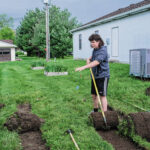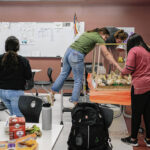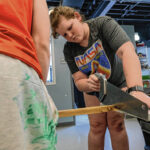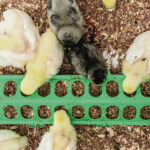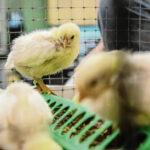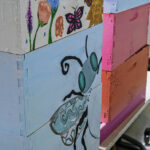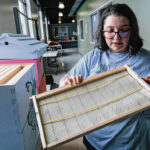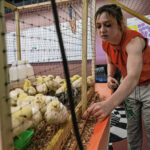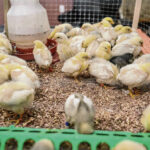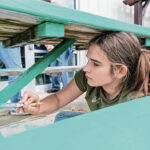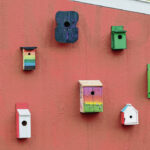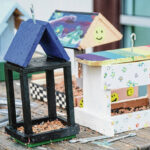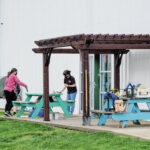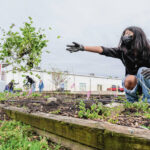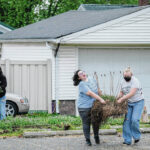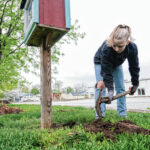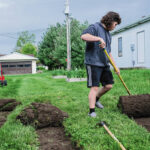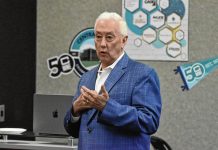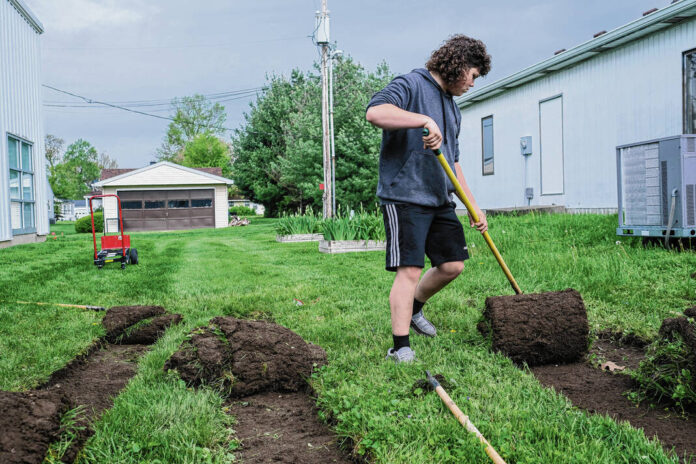
Mike Wolanin | The Republic CSA New Tech ninth grader Briceon Ernest strips sod as part of a series of environmental projects at CSA New Tech in Columbus, Ind., Thursday, May 5, 2022.
BEES, baby chicks and birdhouses have all been a part of Project-Based Learning at Columbus Signature Academy New Tech High School this year.
The Buck Institute for Education defines PBL as “a teaching method in which students gain knowledge and skills by working for an extended period of time to investigate and respond to an authentic, engaging, and complex question, problem, or challenge.”
These problem-solving efforts were on display May 5 as students took part in an afterschool environmental work day, under the leadership of science teacher and Environmental Club mentor Bridget Steele. Some of the day’s work included desodding grass, painting picnic tables and planting flowers.
The environmental club’s goal is to “bring more life to our outdoor campus” and support native species, said Steele. Class projects have also contributed to this endeavor.
For instance, students have been working on a bird sanctuary. The project began with the study of songbirds during a unit on evolution.
“Then we developed bird houses or feeders with those specific songbirds in mind, with each team focusing on a songbird that’s here during the winter that needs our support,” said Steele.
They also raised funds so that they could build a pergola, both for shade and as a place to suspend some bird houses and feeders. The pergola was assembled from a kit. During the environmental work day, students worked on bases for the area where the pergola will be placed and finished up work on some picnic tables that will be placed near the structure.
Recent projects have also focused on pollinators, with Steele’s environmental science students building beehives from kits.
“We built one for ourselves and four other community partners,” she said. “These community partners have been wanting to beekeep for a while. … So we wrapped our project up into theirs. And so we built the hives for them and painted them as they wished.”
The students then held a workshop where they taught these community partners about the basics of beekeeping.
As part of the environmental work day, students used a sod stripper to prepare for the installation of the school’s beehive.
“We’re desodding all of this grass,” said freshman and environmental club member Dane Tibbs. “We’re going to put the hives up here soon, but we’re going to be planting a lot of flowers, and we don’t want weeds to grow in between them, especially since we’re going to be collecting some of the honey later on.”
Steele and the students would also like to create a pollinator garden around the hive.
“We envision the back part of that area of the school as a courtyard with flowers, butterflies, bees, and we’ll probably add some bird feeders back there too, with time,” she said. “We’ve already seen more life being brought to our schoolyard. As we planted some serviceberry trees, there’s been butterflies. Our cherry tree has a nest, a cardinal nest in it. And so we’ve been watching her. And as we put the birdhouses out and the feeders out, just to get them ready, the birds have been visiting.”
Animal life has also been present in the classroom, with students caring for chicks as they study embryology. A $250 grant from the Bartholomew Consolidated School Foundation provided for a double-decker incubator and a brooder chamber, and a local chicken farmer provided the eggs.
The farmer keeps the breed of each egg a secret, with Steele and students making predictions before they hatch. Biology students adopted and named eggs. When chicks were born, they were banded with colored pipe cleaner for identification. There were also examinations of the eggs that didn’t hatch, and those that showed any previous signs of life were buried under the school’s cherry tree.
“It (a chick) has 21 stages, and you can see what stage they stopped at,” said freshman Anell Trinidad. “…One of them was just the egg.”
Others were fully developed but didn’t make it, said Kinleigh Miller.
Shane Ramey noted that it was difficult to watch eggs, not knowing if they would hatch. In Alyssa Whitted and her partner’s case, theirs didn’t, so they adopted another chick. Bex Sidwell’s first chick was “too big for his egg,” she said.
Kinleigh’s egg hatched, but the chick died a few days later due to being very small.
“Now we share chickens with people in another class, so no matter what, everyone gets a baby,” she said.
Students have continued to study the chicks after hatching, using tests and myths to make guesses about which ones are male or female. They’ve also done behavior experiments and are building perches for the chicks, and Bex noted that the birds are beginning to want to fly.
Steele said the students have been very responsible with the chicks, and the chicks have had a calming presence in the classroom.
“That chirping just brings everyone kind of down a couple notches and allows everyone to be calmer and more focused,” she said. “And cuddling a chick brings them to a place of being able to focus and listen very well. And I use them for motivation, too — like, ‘You may get your chicks out when you have completed these three or four tasks.’”
Naturally, students have become fond of the creatures.
“I literally cried for three hours a couple days ago because I couldn’t bring my chicken home,” said Bex.
Steele said the chicks will eventually be returned to the farmer. However, next year she hopes to build a backyard coop so that they can keep a small number of chicks and harvest their eggs. She also plans to continue the hatching project.
“So birds and bees — all of that stuff has been really for real here,” said Steele. “And we’re continuing to add on. Andy Larson, another facilitator that teaches our global science perspective class with all of our freshmen, has also started a tree nursery with our students. They collected seeds in the fall and germinated them, got them into little saplings. And we now have them installed in our garden. In the future, we’re going to make a larger tree nursery in the lot that’s adjacent to our school that we just acquired. We’re really excited about growing our outdoors and making more outdoor learning spaces so that we can take the classroom outside.”
For Steele, the best part of these different projects has been seeing students take ownership and responsibility for the tasks at hand. She said that the school is “their second home”, and they also want to make it more lively and creative. She enjoys giving them freedom to do so.
“Columbus Signature Academy is like nowhere else,” she said. “Here, our students are the ones leading us as much as we are leading them.”
Mike Wolanin | The Republic CSA New Tech ninth grader Briceon Ernest talks about sod stripping being done as part of a series of environmental projects at CSA New Tech in Columbus, Ind., Thursday, May 5, 2022.
Mike Wolanin | The Republic CSA New Tech students tend their chicks as part of a series of environmental projects at CSA New Tech in Columbus, Ind., Thursday, May 5, 2022.
Mike Wolanin | The Republic CSA New Tech ninth graders Bex Sidwell, left, and Alyssa Whitted cut a support for a cage of chicks as part of a series of environmental projects at CSA New Tech in Columbus, Ind., Thursday, May 5, 2022.
Mike Wolanin | The Republic Chicks feed from a trough in a cage at CSA New Tech in Columbus, Ind., Thursday, May 5, 2022. The chicks were hatched and are cared for by CSA New Tech students.
Mike Wolanin | The Republic A chick stands of a feeding trough in a cage at CSA New Tech in Columbus, Ind., Thursday, May 5, 2022. The chicks were hatched and are cared for by CSA New Tech students.
Mike Wolanin | The Republic A view of beehives designed and built by CSA New Tech students for series of environmental projects at CSA New Tech in Columbus, Ind., Thursday, May 5, 2022.
Mike Wolanin | The Republic CSA New Tech 11th grader Lydia Ferril shows beehives designed and built by CSA New Tech students for series of environmental projects at CSA New Tech in Columbus, Ind., Thursday, May 5, 2022.
Mike Wolanin | The Republic CSA New Tech ninth grader Bex Sidwell checks the structural integrity of a cage containing chicks as part of a series of environmental projects at CSA New Tech in Columbus, Ind., Thursday, May 5, 2022.
Mike Wolanin | The Republic Chicks occupy a cage at CSA New Tech in Columbus, Ind., Thursday, May 5, 2022. The chicks were hatched and are cared for by CSA New Tech students.
Mike Wolanin | The Republic CSA New Tech ninth grader Natalie Lewis paints a picnic table as part of a series of environmental projects at CSA New Tech in Columbus, Ind., Thursday, May 5, 2022.
Mike Wolanin | The Republic Birdhouses are attached to a shed at CSA New Tech in Columbus, Ind., Thursday, May 5, 2022.
Mike Wolanin | The Republic A view of some birdhouses built by CSA New Tech students as part of a series of environmental projects at CSA New Tech in Columbus, Ind., Thursday, May 5, 2022.
Mike Wolanin | The Republic A view of a pergola CSA students built to attach birdhouses to for a series of environmental projects is seen outside CSA New Tech in Columbus, Ind., Thursday, May 5, 2022.
Mike Wolanin | The Republic CSA New Tech ninth grader Gaudalupe Castaneda clears a garden bed as part of a series of environmental projects at CSA New Tech in Columbus, Ind., Thursday, May 5, 2022.
Mike Wolanin | The Republic CSA New Tech 11th grader Lydia Ferril, left, and ninth grader Cameron Hatfield carry plants for a series of environmental projects at CSA New Tech in Columbus, Ind., Thursday, May 5, 2022.
Mike Wolanin | The Republic CSA New Tech ninth grader Kinleigh Miller digs a hole to plant irises as part of a series of environmental projects at CSA New Tech in Columbus, Ind., Thursday, May 5, 2022.
Mike Wolanin | The Republic CSA New Tech ninth grader Briceon Ernest strips sod as part of a series of environmental projects at CSA New Tech in Columbus, Ind., Thursday, May 5, 2022.

